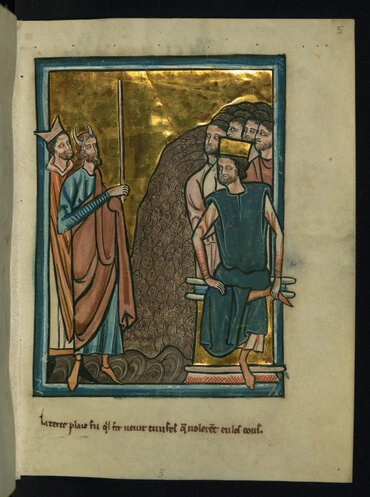1
At sinalita ng Panginoon kay Moises, na sinasabi,

Aaron was the brother of Moses. He symbolizes two things, at different stages of the story.
During the first part of the exodus, when he was Moses' spokesperson, Moses represents the Word as it truly is, as it is understood in heaven, while Aaron represents the Word in its external sense, as it is understood by people in the world. This is why Aaron talks for Moses, and the Lord says of him "he shall be as a mouth for you, and you shall be to him as God." (Exodus 4:16)
Later, after the Tabernacle was built and he was inaugurated as high priest (see Leviticus 8,9), Aaron represents the Lord as to the Divine Good, and Moses represents the Lord as to the Divine Truth.
In Exodus 28:1, Aaron signifies the conjunction of Divine Good with Divine Truth in the Divine Human of the Lord. (Arcana Coelestia 9806, 9936)
In Exodus 32:1, Aaron represents the external of the Word, of the church, and of worship, separate from the internal. (Arcana Coelestia 10397)
In Exodus 4:14, before he was initiated into the priesthood, Aaron represents the doctrine of good and truth. (Arcana Coelestia 6998)
7014. 'And Moses went and returned' means a resumption of the former life. This is clear from the meaning of 'going' as life, dealt with in 4882, 5493, 5605; from the meaning of 'returning', or going back, as living where he had done so formerly; and from the representation of 'Moses' as the Lord in respect of the law or truth from God, dealt with in 6771, 6827. When Moses was on Mount Horeb with Jehovah, who appeared in a flame of fire, he represented the Lord in respect of Divine Truth; but now that he is with Jethro his father-in-law, who is the good of the Church which is guided by the truth that goes with simple good, he represents the Lord in respect of truth from God. Here and elsewhere in the Word the internal sense describes how, during all the states of life which the Lord passed through in the world, He was making His Human Divine. These states followed one after another, as may be recognized from the fact that when He was a young child the Lord was like a young child, and after that grew in intelligence and wisdom, all the time instilling Divine Love into them till at length His Human too became Divine Love, which is Divine Being (Esse) or Jehovah. And this being the way in which the Lord put on the Divine - that is, in one state after another - He therefore first made Himself truth from God, after this Divine Truth, and finally Divine Good. These were the stages in the glorification of the Lord that are described here and elsewhere in the internal sense of the Word.